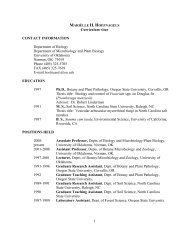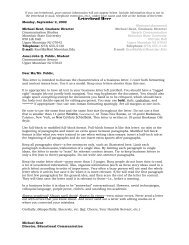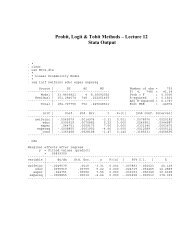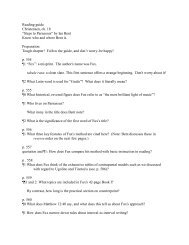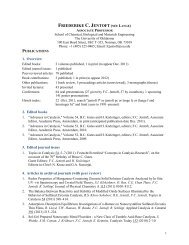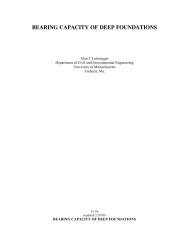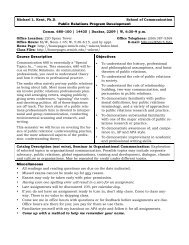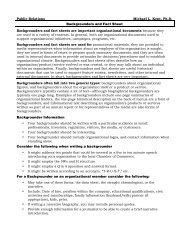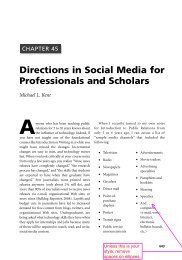Organum – discantus – contrapunctus in the Middle Ages
Organum – discantus – contrapunctus in the Middle Ages
Organum – discantus – contrapunctus in the Middle Ages
Create successful ePaper yourself
Turn your PDF publications into a flip-book with our unique Google optimized e-Paper software.
p. 483<br />
0 What four harmonic <strong>in</strong>tervals are used <strong>in</strong> “flexible” organum accord<strong>in</strong>g to Guido.<br />
Note: it is common to rank <strong>the</strong> harmonic <strong>in</strong>tervals. What is Guido's order<strong>in</strong>g?<br />
p. 484<br />
How closely do <strong>the</strong> <strong>the</strong>oriectical accounts seem to reflect practice?<br />
Chapter 15 <strong>–</strong> p. 2<br />
p. 485<br />
Head<strong>in</strong>g and 1 What o<strong>the</strong>r term is used to refer to two-part writ<strong>in</strong>g <strong>in</strong> <strong>the</strong> 1200s?<br />
What is <strong>the</strong> significance of <strong>the</strong> new term?<br />
What “retronym” is given to chant? (Ask me <strong>in</strong> class about retronyms.)<br />
How are <strong>the</strong> eight modes treated <strong>in</strong> <strong>the</strong> <strong>discantus</strong> <strong>the</strong>ories?<br />
How is <strong>the</strong> word mode used <strong>in</strong> <strong>the</strong> <strong>discantus</strong> writ<strong>in</strong>gs?<br />
2 Who is <strong>the</strong> author of <strong>the</strong> key Parisian treatise on musica mensurabilis? What is its title?<br />
th<br />
Coussemaker was a 19 -century French musicologist who discovered, collected, and<br />
transcribed many early manuscripts on music. He published a four-volume set of Lat<strong>in</strong><br />
works entitled Scriptorum de musica.<br />
p. 486<br />
0 Accord<strong>in</strong>g to John of Garland, how are <strong>the</strong> two <strong>in</strong>dependent voices coord<strong>in</strong>ated?<br />
How many harmonic <strong>in</strong>tervals does John put <strong>in</strong>to his hierarchy? How are <strong>the</strong>y ordered? Are<br />
<strong>the</strong>re any surprises <strong>the</strong>re?<br />
What numerical justification does John give for his hierarchy? What details show that he isn't<br />
exclusively follow<strong>in</strong>g an abstract ma<strong>the</strong>matical <strong>the</strong>ory <strong>in</strong> construct<strong>in</strong>g his scheme?<br />
p. 487<br />
1 A little confus<strong>in</strong>g: an earlier treatise is named, but I th<strong>in</strong>k <strong>the</strong> rest of <strong>the</strong> paragraph cont<strong>in</strong>ues<br />
to refer to John of Garland.<br />
What two reasons are given for waiv<strong>in</strong>g certa<strong>in</strong> rules based on <strong>the</strong> <strong>in</strong>tervallic heirarchy?<br />
John of Garland is characterized as part of an <strong>in</strong>tellectual tradition of <strong>discantus</strong> writ<strong>in</strong>g. Why?<br />
2 What characterizes <strong>the</strong> o<strong>the</strong>r tradition of <strong>discantus</strong> writ<strong>in</strong>g?<br />
p. 488<br />
1 A little confus<strong>in</strong>g aga<strong>in</strong>. Note that Fuller now places “Discantus positio vulgaris” among <strong>the</strong><br />
treatises that show which <strong>in</strong>tervals to write with few explanations. Notice that <strong>the</strong> title<br />
<strong>in</strong>dicates that this is <strong>the</strong> common way to do it, not <strong>the</strong> elite way.<br />
Are accidentals mentioned <strong>in</strong> <strong>the</strong>se treatises?<br />
What k<strong>in</strong>ds of general rules are mentioned occasionally?<br />
p. 489<br />
0 Accord<strong>in</strong>g to Fuller, why does <strong>the</strong> <strong>in</strong>tervallic-succession tradition avoid general explanatory<br />
rules? What do you th<strong>in</strong>k: Did this policy necessarily reflect good pedagogy?<br />
1 Accord<strong>in</strong>g to Anonymous IV, what dist<strong>in</strong>guishes discantors from pla<strong>in</strong> s<strong>in</strong>gers?




